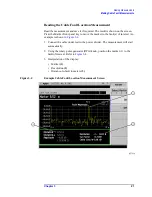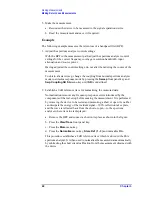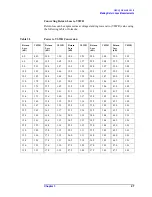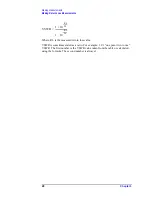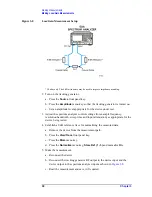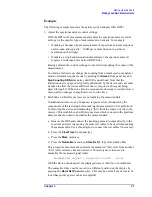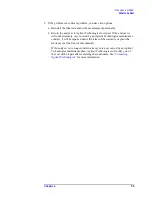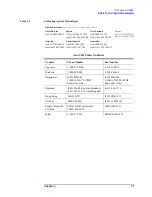
Chapter 3
31
Making Measurements
Making Loss/Gain Measurements
Example
The following example measures the gain/loss of a bandpass filter (BPF).
1. Adjust the spectrum analyzer control settings.
With the BPF in the measurement path, adjust the spectrum analyzer control
settings for the specific type of measurement to be made. For example:
•
If making a bandpass-ripple measurement, the spectrum analyzer requires a
narrow span and typically < 10 dB per vertical division to get more
resolution on the display.
•
If making a stop-band attenuation measurement, the spectrum analyzer
requires a wide span and a narrow RBW filter.
Having adjusted the control settings, do not alter them during the course of the
measurement.
To obtain a faster sweep, change the coupling from normal spectrum analyzer
mode to stimulus response mode by pressing the
Sweep
front panel key and
Swp Coupling SR SA
menu key until SR is underlined. Note that the
limitation on sweep speed is typically determined by the device and care must
be taken to allow the device sufficient time to respond to the signal being
passed through it. If the auto stimulus-response-mode sweep is too fast, slow it
down until no changes in amplitude occur on the trace.
2. Establish a 0 dB reference trace for normalizing the measured data.
Normalization removes any frequency-response errors introduced by the
components of the test setup before making the measurement. It is performed
by removing the device and measuring a ‘thru’ from the source directly to the
receiver. This establishes a 0 dB reference trace which is stored in the spectrum
analyzer and then used to normalize the measured data:
a. Remove the BPF and connect the tracking generator output directly to the
spectrum analyzer input using the same test cables to be used when making
the measurement. Use a thru adaptor to connect the test cables if necessary.
b. Press the
View/Trace
front panel key.
c. Press the
More
menu key.
d. Press the
Normalize
menu key,
Store Ref (1 - 3)
and normalize
On
.
This procedure automatically subtracts the measured ‘thru’ level from an ideal
‘thru’ (a flat reference line) and stores it. This reference is then used to
normalize the measured signal where:
normalized signal = measured signal – error
With the device disconnected, the displayed trace is then flat, or normalized.
The normalized trace can be moved to a different position on the display by
pressing the
Norm Ref Posn
menu key. This may be useful if the device to be
tested has positive gain, such as an amplifier.
Summary of Contents for ESA-E Series
Page 4: ...iv ...
Page 6: ...vi Contents ...
Page 7: ...1 1 Getting Started This chapter describes the process for installing the personality ...
Page 14: ...8 Chapter1 Getting Started Installing the Optional Measurement Personality ...
Page 16: ...10 Chapter2 Menu Maps and Key Descriptions Menus Menus Mode and Measure Menus ...
Page 21: ...15 3 Making Measurements ...
Page 44: ...38 Chapter4 If You Have a Problem Before You Call Agilent Technologies ...
Page 46: ...Index 2 Index ...





